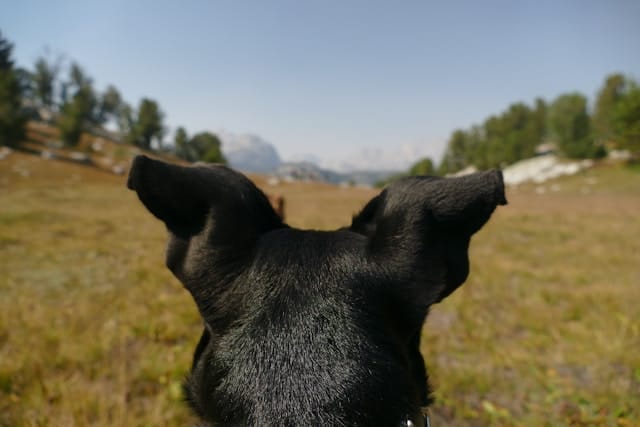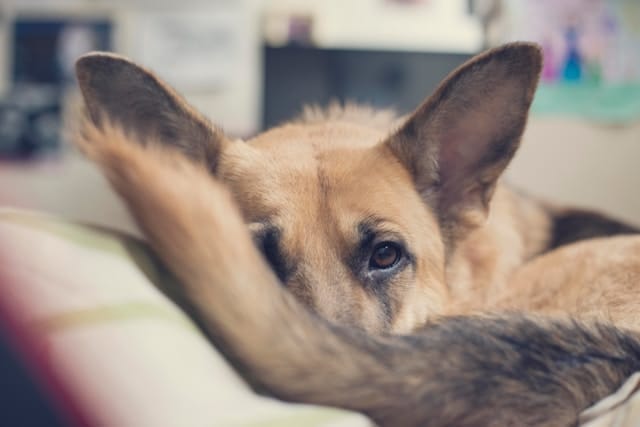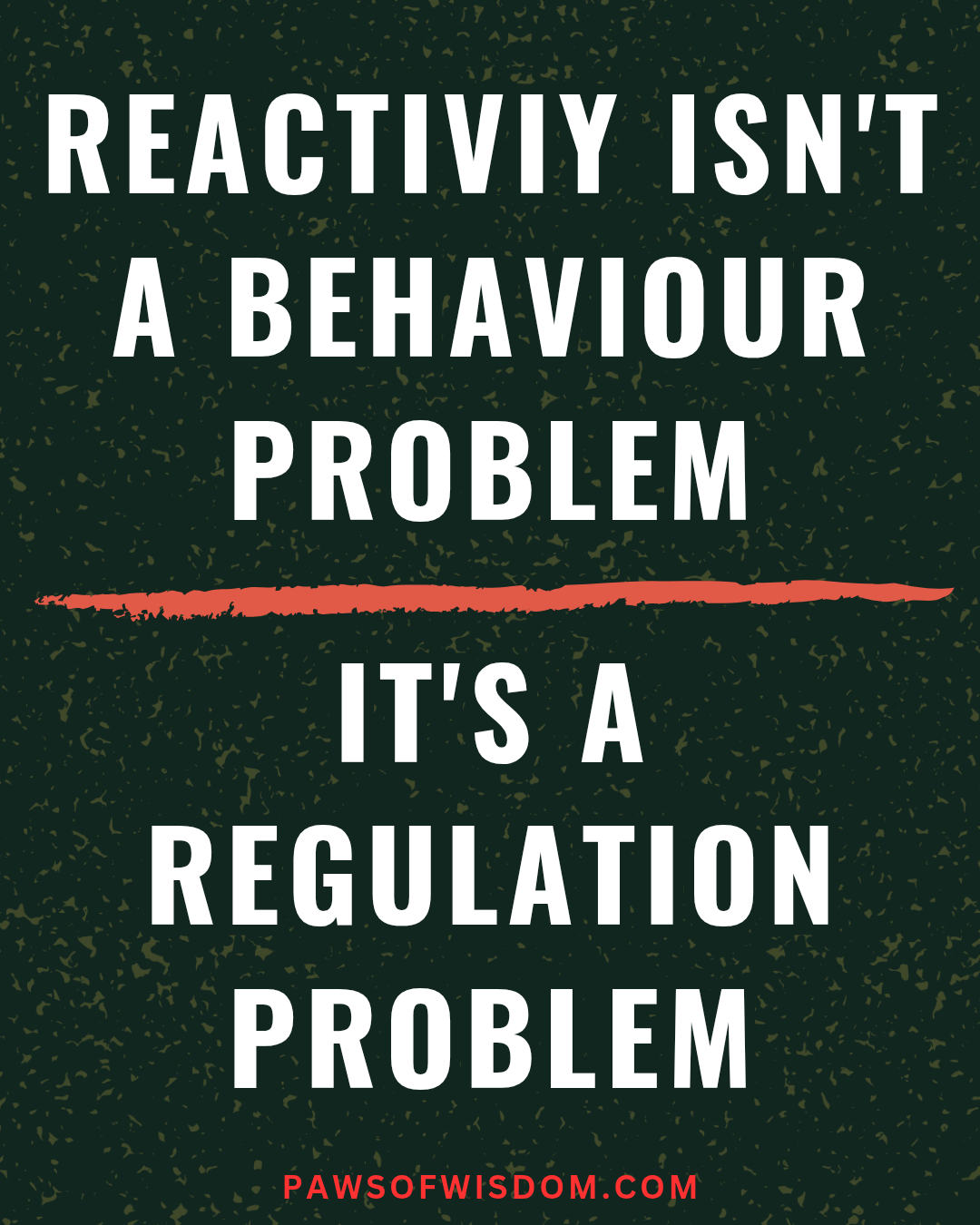Living With a Reactive Dog: What No One Tells You (and What Helped Me Survive It)
Living with a reactive dog comes with so many challenges that most people don’t see or talk about. It’s not just about a barking, lunging, or pulling dog on walks. It’s the emotional rollercoaster of planning every outing and training session, scanning every corner, and constantly being “on” in case something goes wrong (my heart still skips a beat every time I see a dog even when I'm not walking Jasper).
This honestly affects your entire life — from your routine to your mental health to how you feel about your relationship with your dog and even yourself. It can feel so isolating and overwhelming when it feels like you have this invisible weight on your shoulders.
In this post, I'm going to talk about what life with a reactive dog actually looks like — the messy, emotional, real life version (some of it might sound familiar). I’ll walk you through why it feels so damn exhausting, how trigger stacking and stress play a huge and silent role in your dog’s behaviour, and what you can start doing today to move out of survival mode and towards a more harmonious life with your dog.

The Constant Pressure of Managing Reactivity
Living with a reactive dog changes your whole life — not just your walks.
It's like you become the lookout, constantly scanning the environment for movement before your dog even catches a whiff (and then we also wonder who they get that from).
You adjust your entire routine around quiet times, avoid routes that might have people or dogs, and tense up the moment you hear a bark in the distance or see the dreaded sight of a dog walking towards you. You constantly cross streets. Use cars to your advantage as a hiding spot. I even changed my job at the time to make our lives easier.
Any of this sounding familiar yet? Because I can go on...but to sum it up you live on the edge, constantly on the struggle bus.
It’s exhausting — emotionally, physically, mentally...and I personally think we all deserve a gold star.
What Changed Everything (Spoiler…It Wasn’t Just Training)
Yes, training helps, having a solid obedience and engagement foundation will do wonders with you and your dogs transformation — but it wasn’t what truly changed things for me, it was only part of the puzzle.
The shift happened when I finally started to understand the bigger picture:
That stress builds in layers throughout the day
That even if my dog didn’t “react,” the internal load was still stacking
It's okay to set boundaries until it becomes habit
Excitement is fine, excitement/overexcitement without regulation...is not
That without understanding the why behind his behaviour and his emotional state, training alone would never be enough
Reactivity isn’t a switch that dogs have the control of turning off and on (becaue that would be easy and unfortunately the worthwhile things aren't easy). It’s system overload. And, if you don’t learn to track and support the layers underneath, you’ll always feel stuck and repeat the same patterns over and over.
That’s when I stopped just "trying to fix the problem” and started learning to manage the whole dog first before focusing on strategies for reactivity, so he could cope with the mountain we were about to climb.

What Your Dog’s Reactivity Is Really Telling You
When we only look at reactivity as a “behaviour issue,” we miss the bigger message underneath it because reactivity is never just the barking, lunging, or acting like a psychopath — it’s a form of communication and that communication usually is screaming one thing...
“I’m not okay.”
Reactivity is your dog’s nervous system going into fight, flight, or freeze. It’s not a conscious choice — it’s a reflex, and the more dysregulated your dog is, the more often they’ll explode over things that seem “small” — because that system never truly gets a break.
So what could your dog’s reactivity actually mean?
“My cup is already full...”
Stress from earlier in the day (or week, or even longer!) is still in their system. They haven’t had a chance to reset and recover, so every new trigger tips them over the edge faster.
“I don’t get a say...”
When dogs are never allowed to make choices, say “no,” or decompress, they start to lose emotional flexibility. This can increase frustration and also conflict in the relationship. Some dogs may act more impulsively due to the frustration or even just so they can feel some form of control.
“I can’t have what I want...”
This is more of a frustration-based reactivity — like wanting to say hi, but being restrained. This usually stems from a lack of impulse control and also often the sign of a dysregulated dog.
“Everything’s too much.”
Sound, motion, new environments, even too much excitement can overwhelm sensitive and dysregulated dogs. Reactivity becomes their emergency valve that they resort to releasing.

The Bad Days No One Sees...
To be completely honest with you, as hard as you may even try — some days just break you.
You head out with the best of intentions, a solid plan, and a positive attitude...and then you come home crushed. Maybe your dog exploded over something small. Maybe nothing even happened, but your dog was so disengaged and tense all walk that you still came back stressed and shaky because your nervous system never got a break (and chances are your dogs didn't either).
These are the days no one else sees. These are the days that make it so isolating when you don't have a support system or a community of people going through the same thing. These are the days that often push you to burnout.
What's even worse is the self doubt that starts to creep in...
Am I making it worse?
Is my dog ever going to be okay?
Why can’t I just enjoy my dog like other people do?
Can I do this forever?
Would my dog be better elsewhere?
And the cherry on the cake comes from those that just simply don't get it, those who give oversimplified advice like “exercise them more” or “just socialise them properly”...like no shit Susan, what do you think I'm doing?
But let this be a reminder you're on the right track and you can (and will) find a way out...

The Invisible Weight of Trigger Stacking
You may have a bad day and think...that sucked but at least my dog will be better tomorrow.
BUT — if your dog has poor regulation (which reactive dogs generally do) and doesn't get a chance to decompress, they will carry this pressure (stress, frustration, arousal - the unholy trinity) into the next day.
This is trigger stacking and it's such an important concept to know about as a reactive dog owner because it explains so much — why your dog gets stuck in a state of overstimulation, why they can snap unexpectedly, why they struggle to settle down etc...
Trigger stacking happens when stress and frustration pile on throughout the day — or even the week if your dog has poor regulation. It’s the barking dog from the morning, the surprise scooter on your walk, a car door slamming on the way home. Each one adds another brick to their internal load which is why when you get back home they seem more chaotic or act stubborn.
It’s not just reactivity — it can look like hyperactivity, poor impulse control, barking at out the window, zoomies (that seem frantic, not fun), pacing, struggling to sleep, or just not being able to settle.
That’s why understanding trigger stacking in dogs is such a turning point. It helps you stop blaming the last straw — and start recognising the whole stack. Once you understand this you can start managing the issue more efficiently and intentionally.
Want to learn more about trigger stacking and how it impacts behaviour?
👉🏾 Grab my FREE Trigger Stacking Guide — only available in the Regulators Community Resource Vault!
The Power of Decompression, Boundaries, and Routine
One thing that I learned the hard way is that structure is more than just training cues. It’s about creating a life that supports regulation and teaches the foundations of better habits.
The more structure you place, the more freedom your dog will get in the future.The more regulated your dog is, the more choices they'll be able to make.
Some of the biggest game changers?
Rest like it’s your dog's second religion (after chaos obviously)
Set boundaries — for your dog and yourself
Offer decompression time and natural outlets
Stick to a consistent routine
Stop trying to push progress on days your dog’s cup is already full
Start observing and responding — not just blindly reacting
Small Changes That Make a Big Difference
When your dog is constantly reacting, it’s easy to think you need a major intervention, but sometimes, the most powerful shifts start with the smallest of tweaks.
Here are a few changes that helped massively in my journey with Jasper — and they’re super doable, even on your busiest days.
Create a steady routine
Your dog thrives on predictability. Set regular wake, walk, feed, and rest times. This lowers daily stress and helps your dog feel safer and more in sync with you.
Prioritise decompression
Not every walk needs to be “training time.” Let your dog sniff, meander, and decompress without pressure. Sniffari walks, long lines in quiet areas, and just being in nature can work wonders.
Guard their rest
Overarousal doesn’t burn out — it builds up. Make sure your dog gets multiple calm rest periods during the day (not just overnight) in a space where they feel safe and undisturbed.
Remove unnecessary stressors
Ditch the busy routes. Stop rehearsing chaotic situations. Don’t keep “testing” them. Your dog doesn’t need more exposure — they need recovery.
Start tracking patterns
Write down what happened before an outburst. Note their energy levels, interactions, food, rest, and recovery. You’ll start to see what’s actually contributing to the behaviour — and how to interrupt that cycle.
What You Track, You Can Change
Ever have one of those weeks where your dog just feels off — more barky, more restless, less responsive — and you just can’t figure out why?
That used to be me, until I started journaling and tracking our progress.
Not just the meltdowns, but the little stuff too: rest, arousal, routines, patterns, and suddenly, the chaos started to make more sense. I could finally see what was building pressure and how to shift things before it overflowed.
That’s exactly why I created the Digital Dog Training Journal — so you can get the same clarity, without drowning in notebooks.
Clarity, without the chaos!
Track the things that actually impact behaviour — rest, triggers, patterns, goals, progress. This journal includes daily, weekly, and monthly reflections to help you stay grounded, clear-headed, and in sync with your dog’s needs.
✅ Designed for overwhelmed dog owners
✅ Prompts included (so you’re never stuck staring at a blank page)
✅ Use it from your phone, tablet, or desktop
🎯 Stop second-guessing...
👉🏽 [Get the journal now]
Changing Your Perspective
One of the biggest breakthroughs I had with Jasper didn’t come from a new technique believe it or not, it came from changing the way I thought about (and saw) his behaviour.
For the longest time, I was laser-focused on “fixing” the reactivity — managing outbursts, stopping the lunging, getting him to behave. I thought it was a personal attack on me when he couldn't control himself (in the overwhelming situations I was putting him in), so we did more...and the more I chased behaviour, the more stuck we became.
Reactivity isn’t just a behaviour problem. It’s a regulation problem.
And solving it isn’t about suppression — it’s about reshuffling the whole system which means shifting the order you tackle things in, and the mindset you bring to the process.
This means asking…
Am I supporting my dog’s nervous system before asking for obedience?
Are my expectations aligned with their current capacity — or am I setting us both up to fail?
Do my boundaries help my dog feel safe and settled, or are they just rules to follow?
This is where boundaries stop being about punishment — and start being about clarity. They teach your dog what to expect. They give structure to their world. And when paired with regulation work, those boundaries become habits… and those habits turn into freedom.
Shifting your perspective won’t magically fix your dog overnight, but it will unlock a different kind of momentum. One where you’re not constantly firefighting behaviour — you’re rebuilding capacity, connection, resilience, and calm from the inside out.

The Little Things That Helped More Than I Expected...
Living with a reactive dog takes a toll — not just on your routines, but on your mindset, your social life, your identity, and your energy. This is why the importance of self care for dog owners is such a big passion of mine and one I always preach (I do want to start writing more into this because I think self care and perspective are such a huge part of the journey).
These are a few things that helped me keep going, even when everything felt like too much:
#1 - Prioritising my own self-care
I used to think taking time for myself was selfish — until I realised I couldn’t show up for my dog properly if I was running on empty. Whether it was a hot shower, 10 minutes of journaling, taking the time to watch a movie (with a glass of wine), or just stepping outside alone...giving myself space helped me reset.
#2 - Doing things my dog actually enjoys
I stopped forcing the idea of what we “should” be doing — like social walks or busy parks, pub gardens — and focused on what brought my dog joy. Quiet sniffari walks, frozen kongs, flirt pole, learning new things and structured play made a massive difference for both of us.
#3 - Making time for myself outside of my dog
This kind of links in with self care but you shouldn't feel guitly for actually wanting to take time to live your life.
It’s easy to get lost in your dogs needs, their routines, and their issues. That you start struggling to hav you time...reading, going to the gym, talking to friends, going out to enjoy the weather...yes we're dog parents, but we're also people too.
#4 - Tracking the wins (no matter how small)
With my dog and my own journey, journaling has done so much in terms of speeding up my growth. Writing down tiny wins — like “didn’t bark at the postman today” — gave me a thread of hope to hold onto. It reminded me we were growing, even if it was slow. Journaling 1 thing that I'd do better the next day with Jasper helped me keep myself on the right path.
This is something I always recommend to people I work with, purely for the fact that by journaling your progress and spotting the patterns you're making, you can constantly course correct and shift on to the right track.
#5 - Releasing the pressure to be perfect
I think when you have a reactive dog you put a lot of pressure on yourself to make sure everything is perfect. The amount of times I practiced leash walking because I was just so embarrased how Jasper was on walks, it honesly lost a lot of fun.
I learned that I didn't want perfect, and I dont' think any of us actually do, I think a lot of owners would be happy with better...not perfect.
The moment I accepted that, everything started to feel lighter.
TL;DR – The Living With a Reactive Dog Survival Guide
Reactivity isn’t disobedience — it’s a dysregulated nervous system calling for help
Trigger stacking explains why your dog can go from fine to frantic seemingly “out of nowhere”
You can’t train a dog who’s too stressed to think — regulation has to come first
Start with decompression, rest, and reducing overwhelm — not more training drills.
Tracking patterns gives you clarity and control in the chaos
There’s no shame in struggling — and no failure in going slow
Ready for a Reset?
Sometimes, it’s not about adding more obedience, or more walks to the plate. It’s about taking a step back and pressing pause.
That’s exactly what the Paws Of Wisdom Detox Protocol is for! It’s a short, structured protocol to help your dog reset, regulate better, rest deeper, and come back to training with a clearer head — and calmer behaviour, in as little as 5 days.
If it feels like you’ve been stuck in an endless survival mode loop, this may be the soft reboot you're looking for.
Final Thoughts
Living with a reactive dog is messy. It’s emotional. It's isolating...it’s just a lot.
BUT there is a way out. Your dog isn’t beyond help. You can learn to handle your reactive dog with confidence and you don’t need to do this perfectly to actually make progress, you just have to make sure you're going in the right direction and stick with it.
You’re showing up. You’re learning. And that’s where change starts.
Frequently Asked Questions (FAQs): Life With A Reactive Dog
Start by shifting your mindset: socialisation doesn’t mean forcing interactions. Focus on calm, neutral exposures at a safe distance and then build on that. Let your dog observe without pressure. Over time, this builds confidence and can help reduce reactivity.
Avoid flooding them with triggers, or putting them in situations they can’t cope with. Reactive dogs thrive with structure, predictability and calm environments, and — not pressure.
Yes. Progress may be slow and non-linear at times, but with consistent management, decompression, desensitisation/counter-conditioning, and meeting their needs, reactive dogs can improve dramatically.
Because stress builds up over the day. One small event might not trigger a reaction, but multiple over time (noise, poor rest, excitement) can tip your dog over the edge. Understanding trigger stacking helps you see the patterns behind those unpredictable days.
No. I'm a big advocate in skipping walks that don't have any purpose if they are constantly chaos filled outings. Sometimes walks do more harm than good. On high-stress days, skipping the walk in favour of decompression activities, a proper outlet, enrichment, and structured play at home can be more beneficial and less overwhelming.
Related Reading
A FREE community with downloadable guides and resources, and people who get it.
A simple and structured reset for overstimulated, dysregulated, chaotic dogs.
Simple, clear guidance to help you understand your dog through a regulation-first lens.


















